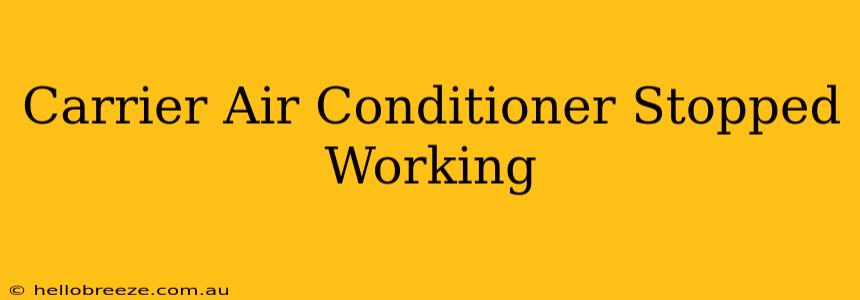Is your Carrier air conditioner suddenly refusing to cooperate? A malfunctioning AC unit can be incredibly frustrating, especially during a heatwave. This guide will walk you through troubleshooting common Carrier AC problems and offer potential solutions. Remember, if you're uncomfortable working with electrical appliances, always call a qualified HVAC technician.
Common Reasons Why Your Carrier AC Isn't Working
Several factors can cause your Carrier air conditioner to fail. Let's explore some of the most frequent culprits:
1. Power Issues: The Simplest Fix
Before diving into complex repairs, check the basics:
- Circuit Breaker: Is the breaker tripped? Locate your home's electrical panel and check for a tripped breaker related to your AC unit. Simply reset it by flipping the switch off and then back on.
- Power Cord: Inspect the power cord for any damage, fraying, or loose connections. A faulty cord needs immediate replacement. Do not attempt repairs yourself if you are not qualified.
- Outdoor Unit Power: Ensure the power is connected to your outdoor condenser unit as well.
2. Thermostat Troubles: The Brain of the System
Your thermostat controls your Carrier AC's operation. Troubleshooting this component is crucial:
- Battery Check: If your thermostat runs on batteries, replace them with fresh ones. Low battery power can disrupt operation.
- Thermostat Settings: Double-check the thermostat settings. Ensure it's set to "Cool," the temperature is appropriately low, and the fan is set to "Auto" or "On" as desired.
- Thermostat Calibration: Over time, thermostats can drift. Consider recalibrating your thermostat according to the manufacturer's instructions or consult their website for specifics on your model.
3. Refrigerant Leaks: A Serious Problem
Refrigerant is essential for your AC unit to cool properly. Leaks result in poor cooling or no cooling at all. This is a job best left to professionals. Low refrigerant is not something you should attempt to fix yourself; it requires specialized equipment and knowledge. Symptoms of a refrigerant leak include:
- Weak airflow: The air coming from the vents is barely cool or not cool at all.
- Frozen evaporator coil: Ice may form on the evaporator coil located inside your indoor unit.
4. Dirty Air Filter: A Simple Yet Overlooked Culprit
A clogged air filter restricts airflow, reducing cooling efficiency and potentially leading to complete failure. Regular filter replacement is key to maintaining your Carrier AC's performance.
- Check and Replace: Locate your air filter (usually accessible behind a panel on your indoor unit). Replace it with a new filter of the correct size and type. Consult your Carrier AC manual for specific filter recommendations.
5. Frozen Evaporator Coil: A Sign of Restricted Airflow
A frozen evaporator coil indicates a problem with airflow or refrigerant levels. Do not attempt to defrost it yourself. This is an indication of a more serious issue that needs professional attention.
6. Capacitor Problems: Power Storage Issues
The capacitor stores electrical energy, which is essential for starting the compressor. A faulty capacitor can prevent your AC unit from turning on or running consistently. Replacing a capacitor requires electrical expertise. Call a qualified technician.
When to Call a Carrier HVAC Technician
While many minor problems can be addressed with simple troubleshooting, some issues require professional attention. Contact a qualified Carrier HVAC technician if:
- You suspect a refrigerant leak.
- The compressor is not running.
- You've tried basic troubleshooting steps, but the problem persists.
- You are uncomfortable working with electrical appliances.
Regular maintenance, including annual inspections and filter changes, can prevent many Carrier AC problems and extend your unit's lifespan. By understanding common issues and knowing when to seek professional help, you can keep your home cool and comfortable throughout the summer.

